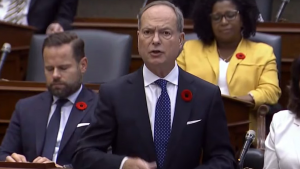TORONTO — Ontario has struck a deal with the federal government to proceed with the province’s Highway 413 project while working together to mitigate the effects on species at risk.
The two governments say they have signed a memorandum of understanding that establishes a joint working group to minimize the planned highway’s environmental impacts in areas of federal jurisdiction.
They say that at their request, the Federal Court has ordered that the Highway 413 project’s designation under the Impact Assessment Act be set aside.
The province had accused Ottawa of overreach when it marked the planned highway for a federal review under the act and had asked the court to stop the federal government from applying the impugned legislation to the 413 project.
Last fall, the Supreme Court of Canada found parts of the Impact Assessment Act to be unconstitutional, ruling it was written in a way that could allow the federal government to make decisions about projects wholly within provincial jurisdiction.
The proposed 52-kilometre Highway 413 connecting the regions of York, Peel, and Halton has been touted as part of the province’s plan to fight gridlock and expand public transit, but environmental groups and other critics say it would encourage sprawl into the protected Greenbelt, pave over prime farmland, and jeopardize the health of at-risk frog and fish species.
The province’s Green Party issued a statement Monday night, saying they will continue to push to get the project quashed. Penned by Deputy Leader and MPP for Kitchener Centre, Aislinn Clancy, the release also calls on Premier Doug Ford to “abandon this environmental wrecking ball and start building homes Ontarians can afford in communities they already spend their time in.”
In an earlier statement, federal Environment and Climate Change Minister Steven Guilbeault said the agreement shows the two governments can work together while recognizing their shared jurisdiction on environmental protections.
“It also ensures federal interests will be maintained on the protection of species while offering Ontario, in light of the recent Supreme Court’s decision, a greater level of clarity around the review process for the Highway 413 Project,” the statement said.
Guilbeault has previously said the top court’s decision left the Impact Assessment Act standing, but the government would work to tighten the parts the court found were too broad. He said that included powers the law gives the environment minister to designate projects for review under the act.
The Canadian advocacy group Environmental Defence issued a statement of its own, calling for Ottawa to swiftly introduce and pass an updated Impact Assessment Act and re-designate the highway for assessment under the new statute as soon as it is in force. It also suggested that if the federal government decided not to act, it would be a reckless betrayal of Ontario residents who trusted federal MPs to protect the environment.
The province thanked the federal government Monday “for meeting us at the table” and said it will work on procurements to “get shovels in the ground on key interchanges of the project” in the coming months.
“Our province is in the middle of a period of unprecedented growth, with gridlock costing our economy upwards of $11 billion every year and we need our infrastructure to keep up,” Transportation Minister Prabmeet Sarkaria said in a statement.
©2024 The Canadian Press











Recent Comments
comments for this post are closed